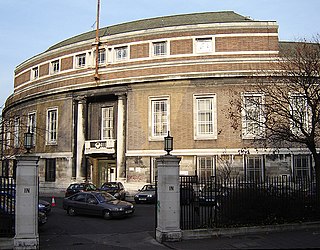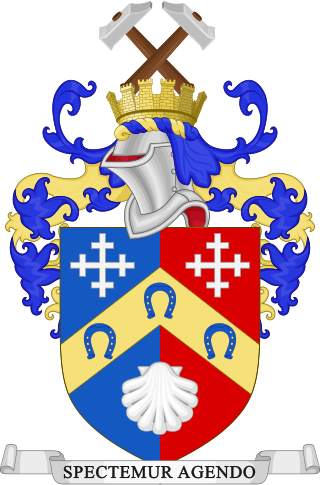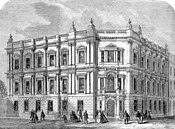
The County of London was a county of England from 1889 to 1965, corresponding to the area known today as Inner London. It was created as part of the general introduction of elected county government in England, by way of the Local Government Act 1888. The Act created an administrative County of London, which included within its territory the City of London. However, the City of London and the County of London formed separate ceremonial counties for "non-administrative" purposes. The local authority for the county was the London County Council (LCC), which initially performed only a limited range of functions, but gained further powers during its 76-year existence. The LCC provided very few services within the City of London, where the ancient Corporation monopolised local governance. In 1900, the lower-tier civil parishes and district boards were replaced with 28 new metropolitan boroughs. The territory of the county was 74,903 acres (303.12 km2) in 1961. During its existence, there was a long-term decline in population as more residents moved into the outer suburbs; there were periodic reviews of the local government structures in the greater London area and several failed attempts to expand the boundaries of the county. In 1965, the London Government Act 1963 replaced the county with the much larger Greater London administrative area.

Islington was a civil parish and metropolitan borough in London, England. It was an ancient parish within the county of Middlesex, and formed part of The Metropolis from 1855. The parish was transferred to the County of London in 1889 and became a metropolitan borough in 1900. It was amalgamated with the Metropolitan Borough of Finsbury to form the London Borough of Islington in Greater London in 1965.

The Metropolitan Borough of Hammersmith was a metropolitan borough in London, England from 1900 to 1965. It included Hammersmith, Wormwood Scrubs, Old Oak Common and Shepherd's Bush.

The Metropolitan Borough of Stoke Newington was a metropolitan borough in the County of London between 1900 and 1965 when it became part of the London Borough of Hackney.

The London Government Act 1899 was an act of the Parliament of the United Kingdom that reformed the administration of the capital. The act divided the County of London into 28 metropolitan boroughs, replacing the 42 local authorities administering the area. The legislation also transferred a few powers from the London County Council to the boroughs, and removed a number of boundary anomalies. The first elections to the new boroughs were held on 1 November 1900.

Hackney was a parish in the historic county of Middlesex. The parish church of St John-at-Hackney was built in 1792, replacing the nearby former 16th-century parish church dedicated to St Augustine. The original tower of that church was retained to hold the bells until the new church could be strengthened; the bells were finally removed to the new St John's in 1854. See details of other, more modern, churches within the original parish boundaries below.

Strand was a local government district within the metropolitan area of London, England, from 1855 to 1900.

Holborn was a local government district in the metropolitan area of London to the north west of the City of London from 1855 to 1900.

St Giles District was a local government district in the metropolitan area of London, England from 1855 to 1900. The district was created by the Metropolis Management Act 1855, and comprised the civil parish of St Giles in the Fields and St George Bloomsbury, Middlesex: the two parishes had been combined for civil purposes in 1774. The district was abolished in 1900 and its former area became part of the Metropolitan Borough of Holborn. The civil parish was abolished in 1930. It is now part of the London Borough of Camden.
The Metropolitan Turnpike Trust was the body responsible for maintaining the main roads in the north of the conurbation of London from 1827 to 1872. The commissioners took over from fourteen existing turnpike trusts, and were empowered to levy tolls to meet the costs of road maintenance.
Plumstead (1855–1894) and then Lee (1894–1900) was a local government district within the metropolitan area of London from 1855 to 1900. It was formed as the Plumstead district by the Metropolis Management Act 1855 and was governed by the Plumstead District Board of Works, which consisted of elected vestrymen.

Hammersmith was a civil parish in London, England, from 1834 to 1965. The hamlet of Hammersmith in the parish of Fulham had been governed by the Hammersmith Vestry following the construction of the chapel of St Paul's in 1629–1631. The Hammersmith Parish Act 1834 made formal the separation from Fulham. The parish was recombined with Fulham as the Fulham District for civil purposes from 1855 to 1886 and for the New Poor Law from 1845 to 1889. In 1900 the parish was superseded for local government by the Metropolitan Borough of Hammersmith. The parish continued to be used for election of boards of guardians until 1930 and was abolished in 1965. Its former area now forms the northern part of the London Borough of Hammersmith and Fulham.
Fulham was a local government district within the metropolitan area of London, England from 1855 to 1886. It was formed by the Metropolis Management Act 1855 and was governed by the Fulham District Board of Works, which consisted of elected vestrymen from the parishes of Fulham and Hammersmith.
The Fulham District Board of Works was a board of works for the parishes of Fulham and Hammersmith from 1855 to 1886.
Hackney was a local government district within the metropolitan area of London, England from 1855 to 1894. It was formed by the Metropolis Management Act 1855 and was governed by the Hackney District Board of Works, which consisted of elected vestrymen. It was in the part of the county of Middlesex that was within the area of the Metropolitan Board of Works. In 1889 it became part of the County of London and the district board functioned as a local authority under the London County Council.

Whitechapel was a local government district within the metropolitan area of London, England from 1855 to 1900.

Woolwich, also known as Woolwich St Mary, was an ancient parish containing the town of Woolwich on the south bank of the Thames and North Woolwich on the north bank. The parish was governed by its vestry from the 16th century to 1852, based in the Church of St Mary until 1842, after which in the purpose-built Woolwich Town Hall. The parish adopted the Public Health Act 1848 and was governed by the Woolwich Local Board of Health from 1852. When the parish became part of the district of the Metropolitan Board of Works in 1855 the local board was treated as if it were an incorporated vestry. It was in the county of Kent until it was transferred to London in 1889. In 1900 it was amalgamated with other parishes to form the Metropolitan Borough of Woolwich and had only nominal existence until it was abolished as a civil parish in 1930. Since 1965 it has been split between the Royal Borough of Greenwich and the London Borough of Newham.

The Hammersmith Vestry was the vestry of Hammersmith from c.1631 to 1900. The vestry was established following the building of a chapel of ease for the inhabitants of Hammersmith in the parish of Fulham. Hammersmith became a distinct parish in 1834 and the vestry was also known as the Vestry of the Parish of Hammersmith.

The Metropolis Management Amendment Act 1885 was a public general act of the Parliament of the United Kingdom of Great Britain and Ireland that amended the Metropolis Management Act 1855 and other Metropolis Management Acts.















